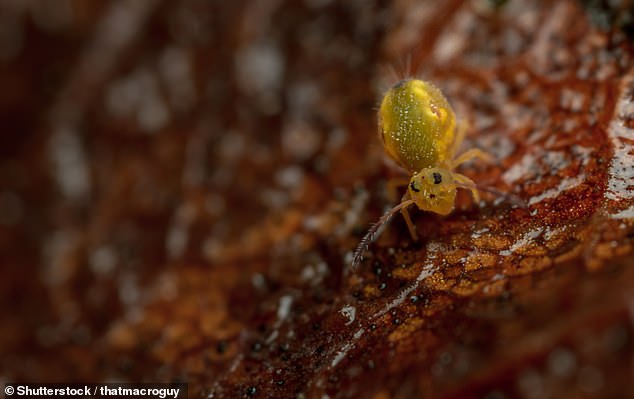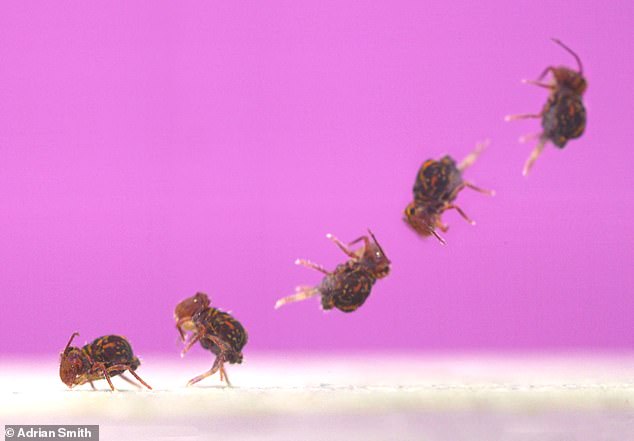When it comes to spinning, jumping creatures, Sonic the Hedgehog might come to mind.
But the video game character pales in comparison to a backyard insect, which claims the title of the fastest-spinning creature on Earth.
The globular springtail (Dicyrtomina minuta) can complete 368 rotations per second, according to new research led by North Carolina State University.
Incredible footage shows the tiny insect showing off its jumping prowess – and it would give the world’s best acrobats a run for their money!
“It’s the closest you can get to a Sonic the Hedgehog jump in real life,” said Dr. Adrian Smith, who led the study.
The globular springtail (Dicyrtomina minuta) can complete 368 rotations per second, according to new research led by North Carolina State University.
Springtails are tiny insects measuring just 0.2 inches (6 mm) long and can be found in gardens across the UK and the US.
Although they cannot fly, bite or sting, they can jump.
In their new study, the researchers set out to understand exactly how insects could do this.
“When springtails jump, they don’t just jump up and down, they flip around in the air,” Dr. Smith said.
Naturally, I wanted to see how they did it.
The researchers “recruited” the springtails for the study in Dr. Smith’s own garden, but filming the speedy insects proved tricky.
“Globular springtails jump so fast that you can’t see them in real time,” Dr. Smith said.
‘If you try to film the jump with a normal camera, the springtail will appear for one frame and then disappear.

Springtails are tiny insects that are just 6mm long and can be found in gardens across the UK and US. While they cannot fly, bite or sting, they can jump.

When you think of bouncing, spinning creatures, you might think of Sonic the Hedgehog. But the video game character pales in comparison to a backyard insect that claims the title of the fastest spinning creature on Earth.
“If you look closely at the image, you can see faint wisps of vapor remaining as it passes through the frame.”
To solve this problem, the researchers used cameras capable of capturing 40,000 frames per second.
Then, by gently poking the insects with a paintbrush or shining a light on them, the team was able to analyse how they took off, how fast and how far they travelled, and how they landed.
The images revealed that globular springtails do not use their legs to jump, but instead rely on an appendage called a furca.
This folds under its abdomen and has a small forked structure at the tip.
When the insect wants to jump, the furca turns downward and the forked tip pushes against the ground, launching them into the air.
“A globular springtail only needs a millisecond to perform a backflip and take off from the ground, and can reach a top speed of 368 rotations per second,” Dr Smith said.
‘They accelerate their bodies by jumping at about the same rate as a flea, but they also turn.

Globular springtails do not use their legs to jump, but instead rely on an appendage called a furca, which folds under their abdomen and has a small forked structure at the tip.
“No other animal on Earth does a backflip faster than a globular springtail.”
The gyrations of globular springtails are not only fast, but also high.
The images revealed that the insects can launch themselves more than 60 millimetres into the air, more than 60 times their own height.
“They can lean to jump and go slightly sideways, but when they launch themselves from a flat surface, they mostly travel up and backward, never forward,” said Jacob Harrison, a co-author of the study.
“Their inability to jump forward was an indication to us that jumping is primarily a means of escaping danger, rather than a form of general locomotion.”
As for landing, researchers identified two equally common styles: uncontrolled and anchored.
During anchored landings, the insects pushed a sticky, forked tube out of their bodies, which could grab onto a surface and stop their momentum.
Meanwhile, during uncontrolled landings, the insects simply bounced and fell to a stop.
“This is the first time anyone has done a complete description of the jumping performance measures of the globular springtail, and what they do is almost unbelievably spectacular,” Dr Smith said.
‘This is a great example of how we can find amazing and largely undescribed organisms living all around us.’

